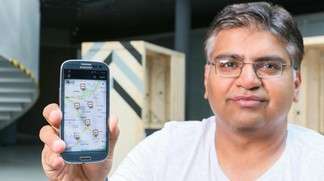An app to steer clear of Kenya's road hazards

The roads in Nairobi are studded with potholes, ditches and other rough spots. There are no signs to warn people driving matatus – the ubiquitous minibuses in the region – of the hazards lying in wait. And in a city of 3.1 million residents, where the state of the roads reflects that of the economy, repair work often only comes in fits and starts. But a new app called CommuniSense, developed with EPFL, intends to change things.
Its goal is to turn citizens into volunteer road surveyors. The idea took shape in Nairobi with the help of Kenyan student Jidraph Njuguna. "I wanted to do something about the dangers that I've been seeing since I was a kid," he said. "There is a saying here that drivers will rather risk swerving into the oncoming traffic lane than go through the potholes. At night the situation gets worse since not many roads have streetlights and sometimes you can find yourself flying from the seat of your car if you encounter an unmarked speedbump."
The point man on the project is Darshan Santani, an electrical engineering doctoral candidate at Idiap (a research institute affiliated with EPFL) in Martigny, who interned at IBM Research Africa in 2014. He developed the CommuniSense concept, which is based on volunteering and crowdsourcing, by driving the roads of Nairobi for three months. "People just need to take photos of the problem zones, which will then appear on a map via their smartphone and could potentially be sent to the authorities," said the 31-year-old researcher. This approach is only possible thanks to the widespread use of smartphones in Africa. More than 78% of the population has a mobile phone, mostly low-cost models that run Android.
The long-run objective of CommuniSense is threefold. First, to virtually map out the road hazards. Second, to inform the authorities of the hazards so that the necessary work will get done. And finally, to encourage citizens to get involved directly as part of their civic duty. "People take action when it comes to problems that affect them, and crowdsourcing via mobile phones is a powerful tool that enables people to help each other out," said Darshan Santani. He points out that even though the project was developed in Nairobi, it could work in other developing cities and countries.
Given the scope of the problem, the app won't be a miracle solution for fixing the roadways. But that doesn't stop its creators from imagining alternatives. "Sections of road could be maintained by businesses as part of a corporate social responsibility agreement," said Darshan Santani. "Funds could also be raised by residents from private businesses in order to fix certain roads," said Prof. Daniel Gatica-Perez, who leads the Social Computing Group at Idiap and the School of Engineering (LIDIAP-STI) sees it as a sort of Kickstarter for urban infrastructure.
More information: "CommuniSense: Crowdsourcing Road Hazards in Nairobi." infoscience.epfl.ch/record/209 … Idiap-RR-15-2015.pdf
Provided by Ecole Polytechnique Federale de Lausanne





















